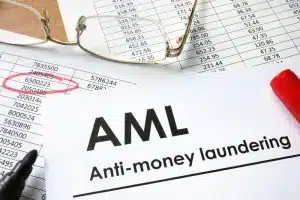 Money laundering is the process of concealing the origins of illicitly-obtained money so that it appears to have been obtained from a legitimate source, we take a look at the 3-stages of money laundering. This typically involves moving the money through a series of complex financial transactions in order to make it more difficult to trace. Money laundering is a serious criminal offence, and there are various anti-money laundering regulations in place to combat it.
Money laundering is the process of concealing the origins of illicitly-obtained money so that it appears to have been obtained from a legitimate source, we take a look at the 3-stages of money laundering. This typically involves moving the money through a series of complex financial transactions in order to make it more difficult to trace. Money laundering is a serious criminal offence, and there are various anti-money laundering regulations in place to combat it.
There are three main stages of money laundering: placement, layering, and integration. Placement is the first stage, and involves introducing the illicitly-obtained money into the financial system. Layering is the second stage, and involves moving the money through a series of complex transactions in order to disguise its origins.
Integration is the third stage, and involves returning the laundered money back into the economy as legitimate funds. Anti-money laundering regulations aim to target all three of these stages in order to effectively combat this crime
What is money laundering?
Money laundering is the process of moving money that has been gained through criminal activity into legitimate channels. This can be done in a number of ways, but the most common method is to use the money to purchase assets, such as property or businesses, which can then be sold for a profit. Money laundering allows criminals to profit from their illegal activities without having to directly deal with the proceeds of crime.
It also makes it difficult for law enforcement agencies to trace the origins of the money and track down the individuals involved in the criminal activity. As a result, money laundering is a serious problem that needs to be addressed. There are a number of ways to prevent and detect money laundering, and it is an issue that is being tackled by both national and international organisations.
The three stages of money laundering
It’s helpful to understand the three stages involve before you can put these anti-money laundering checks in place.
1. Placement
The first step in money laundering is placement, in which the criminal proceeds are introduced into the financial system. This can be done by purchasing assets, such as property or art, or by making deposits into a bank account. Once the money has been placed, it can then be mixed with other funds and used to purchase different assets. This makes it more difficult to trace the origins of the funds.
The final step is integration, in which the laundered money is moved back into the legitimate economy. This can be done by investing in a business or using the funds to purchase luxury goods. Money laundering is a serious crime that has devastating effects on society. It allows criminals to profit from their illegal activities and finance further criminal activity. It also erodes public trust in the financial system and can lead to economic instability.
-
False invoice creation
-
Putting money into cash-based businesses
-
Opening foreign bank accounts
-
Creating offshore companies
-
Moving small amounts of money at a time
2. Layering
Layering is the process of creating different levels or tiers within an investment portfolio. The goal of layering is to mitigate risk by spreading investments across a variety of assets, industries, and geographical regions. Layering can also help to maximize returns by taking advantage of different market conditions.
For example, a portfolio that includes both stocks and bonds will typically perform better during a recession than one that consists solely of stocks. By careful planning and diversification, layering can help investors regardless of market volatility and achieve their financial goals.
Layering tactics might include:
-
Trading across international markets
-
Purchasing foreign money orders
-
Foreign currencies trading
-
Purchasing and selling luxury items
3. Integration
Integration is the final stage of money laundering, and it refers to the process of reintroducing the laundered funds back into the criminal’s legitimate financial accounts. By doing so, the criminal can effectively conceal the source of their ill-gotten gains and make it appear as if they have obtained the money through legitimate means. Integration can be a complex and complicated process, but it is essential for those who wish to successfully launder large sums of money.
There are many ways to integrate funds, and the method that is used will often depend on the amount of money that needs to be laundered. In some cases, Integration may involve opening new bank accounts in different countries or using shell companies to move the money around. Regardless of the method, Integration is a key step in any money laundering scheme.
-
Placing fake employees on the payroll
-
Paying directors loans of a shell company
-
Paying shareholders dividends of criminal-controlled companies
UK anti-money laundering regulations
To comply with the uK money laundering regulations you need to look for red flags at each of these three stages. Anti-money laundering policy is implemented within the UK by, the Financial Conduct Authority (FCA) and Her Majesty’s Revenue and Customs (HMRC). It’s important for businesses to ensure compliance with all regulations of the anti-money laundering act. Current anti-money laundering acts include:
-
2002 Proceeds of Crime Act: is required that banks put anti-money laundering checks in place including transaction monitoring and detailed financial reporting
-
2017 Money Laundering Regulations: Requires all companies to submit written risk assessments
-
2019 Money Laundering Regulations: Extends the scope of anti-money laundering regulations including a more detailed requirement for customer due diligence
Protect your business with anti-money laundering checks
Your business can help to identify and report potential money laundering activity to the relevant authorities. By collaborating with other businesses and law enforcement agencies, you can play a key role in disrupting the illegal flow of money and bringing those involved to justice.
Incorporating data analytics into your business can be a great way to streamline your operations and get ahead of any potential fraud. Integration is key when it comes to using data analytics, as you’ll need to make sure that all of your systems are working together in order to get the most accurate picture possible. Once you have data analytics in place, you can start to monitor patterns and look for any anomalies that might indicate fraud.
This is a great way to keep your business safe and ensure that you’re catching any potential problems before they become too big. In addition to data analytics, it’s also worth training all personnel to be on the lookout for signs of fraud. By understanding the three stages of fraud, your employees will be better equipped to catch any problems early on. Implementing these measures above can help you keep your business safe from fraud and ensure that you’re always one step ahead when it comes to money laundering.
Lee Jones is a seasoned Business Finance Specialist with over two decades of invaluable experience in the financial sector. With a keen eye for market trends and a passion for helping businesses thrive, Lee has become a trusted advisor to countless organizations seeking to navigate the complexities of finance.


